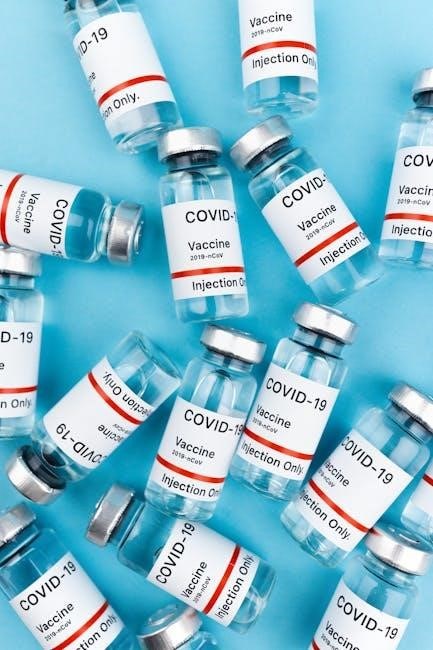Importance of Reading Medication Labels
Reading medication labels ensures safe usage, prevents dosage errors, and helps identify key information like ingredients, warnings, and instructions, making it crucial for patient safety and effective treatment outcomes.
1.1 Why Medication Labels Are Critical for Safety
Medication labels provide vital information, such as dosage instructions, warnings, and active ingredients, ensuring safe and proper drug administration. They help prevent overdose, allergic reactions, and drug interactions; Clear labels enable patients to follow usage guidelines accurately, avoiding potential harm and ensuring the medication’s intended therapeutic effect. Misreading labels can lead to serious health consequences.
1.2 Consequences of Misreading Medication Labels
Misreading medication labels can lead to dosage errors, allergic reactions, or drug interactions, resulting in severe health complications. Overdose or underdose scenarios may occur, causing adverse effects like dizziness, organ damage, or even life-threatening conditions. Inaccurate usage can also reduce the efficacy of treatment, prolonging recovery or worsening medical conditions, emphasizing the importance of careful label reading to ensure patient safety.

Key Sections of a Medication Label
A medication label includes essential sections like the drug name, dosage instructions, warnings, precautions, storage details, and expiration date to ensure safe and effective use of the medication.
2.1 Generic vs. Trade Name of the Medication
The generic name is the drug’s official scientific name, while the trade name is the brand name. For example, ibuprofen is generic, and Advil is a trade name. Knowing both helps avoid confusion and ensures the correct medication is used, especially when comparing different brands or versions of the same drug. This distinction is crucial for safe administration and understanding of prescriptions.
2.2 Dosage Strength and Instructions
Dosage strength specifies the amount of active ingredient per dose, such as 200 mg per 5 mL. Instructions outline how much to take, frequency, and method of administration, e.g., orally or intramuscularly. Properly following these ensures effectiveness and safety, preventing underdose or overdose. Always check for special instructions, like refrigeration, to maintain potency and ensure proper usage, as indicated on the label. This critical information guides accurate medication administration.
2.3 Warning Labels and Precautions
Warning labels alert users to potential risks, such as side effects or allergic reactions. Precautions may include avoiding certain activities, like driving, or interactions with other medications. These labels ensure safe use by highlighting critical safety information, enabling users to take necessary precautions and avoid adverse reactions. Always review warnings to minimize health risks.
2.4 Storage and Disposal Information
Medication labels provide storage instructions, such as refrigeration requirements or room temperature storage. Proper storage ensures potency and safety. Disposal information may include take-back programs or instructions to discard expired medications. Always follow these guidelines to maintain drug effectiveness and prevent environmental contamination. Improper disposal can harm the environment or lead to accidental ingestion.

Understanding the Drug Facts Label
Understanding the Drug Facts Label is crucial for identifying active ingredients, following usage directions, and recognizing warnings, ensuring safe and effective medication use.
3;1 Identifying Active Ingredients
Identifying active ingredients on a drug label helps determine the medication’s purpose and potential interactions. This section lists the chemical name and strength, ensuring users know exactly what they’re taking. For instance, in the provided worksheet, carboprost tromethamine is listed as the active ingredient with a strength of 250 mcg per mL. This clarity is vital for safe administration and avoiding allergic reactions or drug interactions. By focusing on this section, patients can make informed decisions about their medication regimen.
3.2 Understanding Usage Directions
Usage directions on medication labels provide clear instructions for administration, ensuring safe and effective use. This section specifies dosage, frequency, and method of administration, such as “intramuscular use only” or “take with food.” Worksheets help users interpret these directions, preventing errors and enhancing adherence to prescribed regimens. Clear instructions are vital for maximizing therapeutic benefits and minimizing risks. Proper understanding ensures medications are used as intended.
3.3 Recognizing Warnings and Side Effects
Medication labels include warnings and side effects to alert users about potential risks. Understanding these sections helps identify allergic reactions, drug interactions, or specific precautions. Worksheets often highlight these areas, enabling users to recognize critical safety information. This knowledge empowers individuals to use medications safely, avoid harmful interactions, and seek medical advice when necessary, ensuring better health outcomes and reduced risks. Proper recognition is essential for patient safety.

Using a Reading Medication Labels Worksheet
A worksheet enhances comprehension by guiding users through label sections, ensuring they identify key details like dosage, warnings, and usage instructions effectively and accurately for better understanding.
4.1 How to Identify Key Information on the Label
A worksheet guides users to locate and interpret essential details on medication labels, such as active ingredients, dosage instructions, warnings, and storage requirements. By systematically reviewing each section, individuals can enhance their understanding and ensure accurate interpretation of critical information, reducing errors and improving medication safety through clear and organized learning exercises.
4.2 Answering Questions About the Label
Worksheets often include questions that test comprehension of medication labels, such as identifying ingredients, dosage instructions, and warnings. These exercises help users practice extracting key details, ensuring accurate interpretation. By answering questions, individuals reinforce their understanding and improve their ability to apply label information in real-life scenarios, enhancing medication safety and adherence to instructions.
4.3 Practical Scenarios for Applying Label-Reading Skills
Worksheets often include real-life scenarios, such as choosing the right medication for a specific condition or understanding storage instructions. These exercises help users practice applying label-reading skills to practical situations, ensuring they can make informed decisions in real-world healthcare settings. This hands-on approach enhances their ability to interpret and use medication information accurately and safely.

Storage and Disposal Guidelines
Proper storage conditions, like refrigeration or room temperature, and safe disposal methods are critical to maintain medication potency and prevent environmental harm. Always check expiration dates.
5.1 Proper Storage Conditions
Medications often require specific storage conditions, such as refrigeration or room temperature, to maintain potency. Always check the label for instructions like “Refrigerate at 2-8°C” or “Store in a cool, dry place.” Protect medications from light and moisture to ensure effectiveness. Improper storage can lead to degradation, reducing the drug’s efficacy or safety. Always verify expiration dates and follow label guidelines carefully.
5.2 Safe Disposal Methods
Proper disposal of medications is crucial to prevent environmental harm and accidental ingestion. Use authorized take-back programs or sealed containers for disposal. Never flush medications unless explicitly instructed on the label. Remove personal information from labels for privacy. Check expiration dates and dispose of expired drugs safely. Always follow label guidelines to protect health and the environment effectively.
Case Studies and Practical Examples
Real-life scenarios, such as identifying proper dosages or recognizing warnings, provide practical examples for understanding medication labels. These examples help students apply label-reading skills effectively in real-world situations.
6.1 Real-Life Scenarios for Label Reading
Real-life scenarios, like choosing the right medication for symptoms or understanding dosage instructions, help students practice label reading. These examples simulate actual situations, making learning interactive. Worksheets often include scenarios where students match labels to patient needs, enhancing their ability to apply knowledge in practical contexts, ensuring safe and effective medication use.
6.2 Analyzing Medication Labels in Different Situations
Analyzing medication labels in various scenarios, such as emergencies or routine use, helps students understand how to apply label-reading skills. Worksheets often include exercises like matching labels to scenarios or role-playing activities, ensuring learners can interpret dosage instructions, warnings, and storage details accurately in real-world contexts, enhancing their ability to make informed decisions.
Benefits of Using Generic Medications
Generic medications offer cost savings and equivalence to brand-name drugs, providing affordable treatment options without compromising quality or effectiveness, as they meet the same regulatory standards.
7.1 Cost Savings
Generic medications are significantly more cost-effective than brand-name drugs, offering substantial savings for patients. They are priced lower because they don’t require initial research and development costs. This makes them more affordable and accessible, reducing financial strain on individuals and families. By choosing generics, patients can lower their healthcare expenses while maintaining the same therapeutic benefits, ensuring cost-effective treatment without compromising quality. This financial relief is particularly beneficial for those requiring long-term prescriptions or paying out-of-pocket for medications.
7.2 Equivalence to Brand-Name Drugs
Generic medications are FDA-approved as bioequivalent to brand-name drugs, ensuring they contain the same active ingredients and provide the same therapeutic effects. They must meet strict regulatory standards for strength, purity, and performance. While inactive ingredients may differ, such as fillers or coatings, the effectiveness remains identical. This equivalence allows patients to trust generics as safe, reliable, and cost-effective alternatives to brand-name medications, without compromising on quality or efficacy.

Visual Aids and Symbols on Labels
Visual aids and symbols on labels enhance comprehension by using recognizable icons and color-coding to convey critical information quickly. They improve readability for diverse audiences and ensure safety.
8.1 Common Symbols and Their Meanings
Common symbols on medication labels, like warning signs, storage indicators, and dosage instructions, help users quickly grasp essential information. Symbols such as an exclamation mark for caution, a refrigerator for storage, or a hand for administration guide patients effectively, reducing reliance on text and minimizing errors. These visual cues enhance understanding and ensure safe medication use.
8.2 Color-Coding and Label Design
Color-coding and label design play a crucial role in making medication labels visually clear. High-contrast colors enhance readability, while consistent design elements like bold text for warnings and clear fonts for instructions ensure easy comprehension. Logical layouts and visual cues, such as icons or images, help users quickly locate critical information, improving overall understanding and safety.

Best Practices for Patients
Being proactive with medication safety is crucial. Reading labels carefully ensures understanding of active ingredients, directions, and warnings. Patients should ask pharmacists for clarification and follow storage guidelines to guarantee safe and effective use.
9.1 Asking Pharmacists for Clarification
Patients should always ask pharmacists for clarification if medication labels are unclear. Pharmacists can explain complex terms, dosage instructions, and warnings, ensuring safe and proper use. This step is crucial for avoiding errors and understanding potential interactions or side effects, especially for those with limited literacy or vision impairments. Clear communication enhances safety and adherence to treatment.
9.2 Checking Expiration Dates
Checking expiration dates on medication labels is essential to ensure safety and effectiveness. Expired medications may lose potency or become unstable, posing health risks. Always verify the expiration date before use and discard expired drugs properly. This practice helps maintain therapeutic efficacy and prevents potential harm, ensuring medications remain reliable and safe for consumption.
